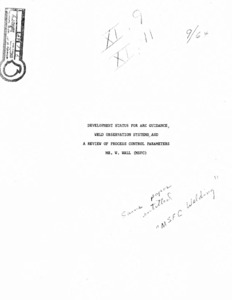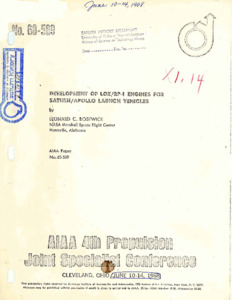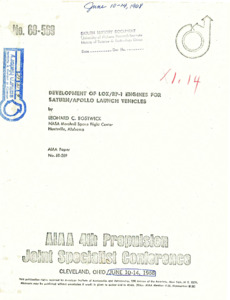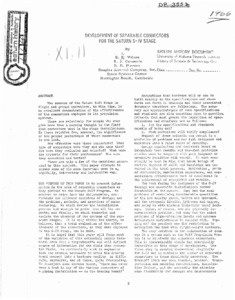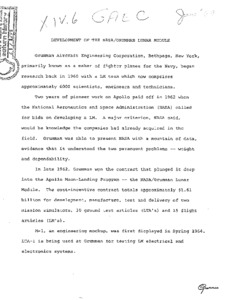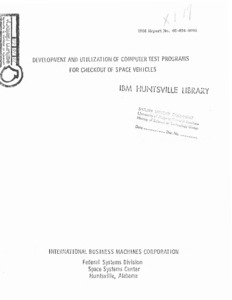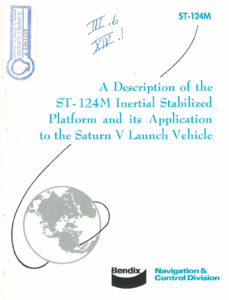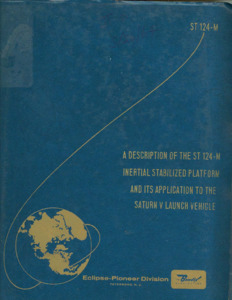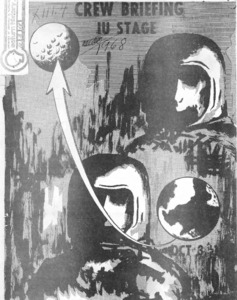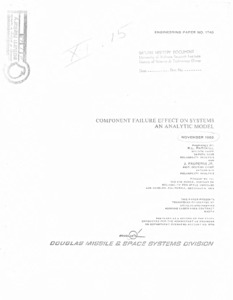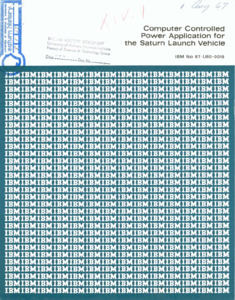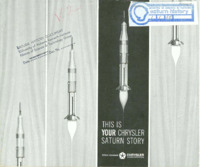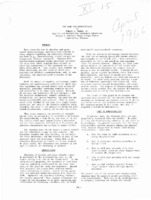
Browse Items (175 total)
Sort by:
-
"Development Status for Arc Guidance, Weld Observation Systems, and a Review of Process Control Parameters."
Letter to David L. Christiensen from W. A. Wall, enclosing requested documents. -
Development of LOX/RP-1 engines for Saturn/Apollo launch vehicles.
The development of liquid rocket engines follow similar patterns regardless of engine size. During the development of the H-1 and F-1 engines, may problems were encountered. Mehtods of solving the combustion instability problem are discussed.; AIAA 4th Propulsion Joint Specialist Conference, Cleveland, Ohio, June 10-14, 1968.; Also available on NASA Technical Reports Server (NTRS) as unclassified. Can be ordered. Also on AIAA. -
"Development of LOX/RP-1 Engines for Saturn/Apollo Launch Vehicles."
The development of liquid rocket engines follow similar patterns regardless of engine size. During the development of the H-1 and F-1 engines, many problems were encountered. Methods of solving the combustion instability problem are discussed. A description is given of the major components of each engine, outlining their unique features. The requirements for an insulation cocoon are discussed. Problems associated with materials substitution are provided; also highlighted is the fact that problems occur after engine deliveries and require continued development support. Safety features incorporated on the engines are mentioned. Solution to problems encountered in flight are discussed. Upratings of both engines systems are presented graphically.; On the NASA Technical Reports Server (NTRS) unclassified. Can also be found on AIAA. -
"Development of Separable Connectors for the Saturn S-IV Stage."
The purpose of this paper is to present information, in the area of separable connectors as they pertain to the Saturn S-IV Program. -
"Development of the NASA/Grumman Lunar Module."
Paper regarding the actions and achievement of the Grumman Aerospace Corporation. -
"Development and Utilization of Computer and Test Programs for Checkout of Space Vehicles."
A computer system was designed to allow test engineers to progressively employ automation in the checkout of the Uprated Saturn I and Saturn V space vehicle programs and still allow manual control of the checkout process. A two-computer system was selected by National Aeronautics and Space Administration, and the International Business Machines Corporation was chosen to provide the programming engineering necessary to implement these objectives. Space vehicle checkout, prior to launch, may be characterized by controlling, monitoring, and testing the vehicle and its subsystems through the use of ground support equipment (GSE).; IBM Huntsville Library.; Presented at AIAA Conference, XVIIth International Astronautical Congress, Madrid, Spain, October 10-15, 1966 by Edward A. Robin, Manager, Vehicle Test Programming Department. -
"A description of the ST-124M inertial stabilized platform and its application to the Saturn V launch vehicle."
This report is a description of the ST-124M inertial stabilized platform system and its application to the Saturn V launch vehicle. It is a summary report providing the system concept, and not a theoretical presentation. Mathematical equations were included only where necessary to describe the equipment; however, the detailed derivations supporting these equations were not presented since this was not the theme of the paper. -
"A Description of the ST 124-M Inertial Stabilized Platform and its Application to the Saturn V Launch Vehicle."
This report is a description of the ST124-M inertial stabilized platform system and its application to the Saturn V launch vehicle. It is a summary report providing the system concept and not a theoretical presentation. Mathematical equations were included only where necessary to describe the equipment; however, the detail derivations supporting these equations were not presented since this was not the theme of the paper. -
"Crew Briefing : Instrument Unit Stage Presentation".
Document outlining different slides of a presentation containing numerous organizational charts, diagrams and bullet-list points. -
"Crew Briefing : Instrument Unit Stage Presentation".
Document outlining different slides of a presentation containing numerous organizational charts, diagrams and bullet-list points. -
"A comparison of four control systems proposed for Saturn V launch vehicles."
Presented are the results of a study comparing four proposed control systems for the first stage flight of Saturn V launch vehicles. The primary basis of comparison is the effect on structural loads, using the bending moments at three stations as load indicators. Two of the systems sense only the vehicle attitude and attitude rate, while the other two systems also sense the lateral acceleration. A yaw plane wind response analysis, including rigid body translation, rigid body rotation, four bending modes, five slosh modes, and a non ideal control system, was performed. The winds used in the study were the Marshall synthetic profile and three selected Jimsphere-measured real wind profiles. Load relief obtained from the addition of accelerometer feedback in the control loop amounted to about 10 percent at maximum bending moment station. In view of predicted structural capabilities of the vehicle, this reduction in loads was not considered sufficient to offset the added complexity and the slight reduction in rigid body stability . -
"Component Failure Effect on Systems: An Analytical Model".
Prepared by R. L. Parkhill, Section Chief, Saturn S-IVB Reliability Analysis and J. Pauperas JR., Asst. Section Chief, Saturn S-IV Reliability Analysis. Presented to the 4th Annual Seminar on Reliability for Space Vehicles, Los Angeles, California, December 6, 1963. This paper presents techniques originated by Douglas Engineering working under NASA contract NAS7-1. Prepared as a record of the study conducted for the Administrative Engineer on the Department Overhead Account No. 9703.; SUMMARY: In today's complex systems, such as Saturn, many traditional reliability analysis concepts are not acceptable. Because of time and budget restrictions, and the requirement to provide a "man rated" space vehicle, the Douglas Saturn Engineering Reliability Section has developed a new analytical approach; it is called "criticality ranking". It is a "totem pole" of components whose single failure may lead to system loss. "Criticality ranking" is one of the results of an analytical model which encompasses failure effect and reliability prediction. This paper describes this analytical model, discusses some of the techniques and ground rules, and presents examples. A discussion of the application of the results is also included. -
"Computer Controlled Power Application for the Saturn Launch Vehicle".
This paper describes a real-time digital computer program that controls the application of electrical power to the S-IVB stage of the Saturn vehicle at Cape Kennedy, Florida. Douglas Aircraft Company, the S-IVB stage manufacturer, provided NASA with the program requirements relative to the energizing sequence, voltage and current measurement tolerances, and vehicle system operational tests. International Business Machines Corporation provided NASA with the computer program to satisfy the task requirements. The program conjoined the components of the Electrical Support Equipment (two RCA 110A computers and control and instrumentation devices) into a closed loop system. The supporting operating system program by IBM is described. -
"This is Your Chrysler Saturn Story."
The document is a booklet created as part of the NASA/Chrysler Corporation Space Division manned flight awareness program. It discusses Chrysler's role in manufacturing and testing the Saturn and includes photographs and diagrams of Saturn stages, operations at Michoud, testing, and future missions. The section headings included in this booklet are "Chrysler and the Saturn," "Saturn at Michoud," "The Voyage of Saturn," "Saturn Firings," and "Saturn's Missions." -
"The Case for Compatibility."
"The Case for Compatibility" is a paper by Robert L. Smith, Jr., who worked in Quality and Reliability Assurance Laboratory at George C. Marshall Space Flight Center. The summary states, "Ever since the use of missiles and space launch vehicles began, questions have existed in every program regarding the similarity between upstream (e.g., manufacturing, static firing ) and launch site checkout equipment. Programs have existed which utilized nearly identical equipment for both uses; other programs have existed in which any resemblance of the equipment was probably coincidental. Many factors have entered the final decisions, not the least of which were economic and schedule considerations, and, in some instances, the organizational structure of the developer."
